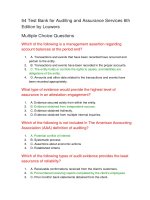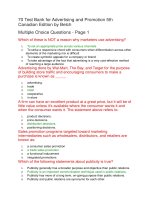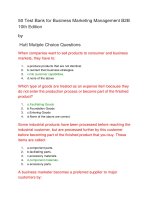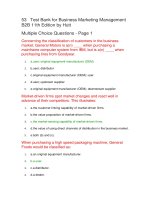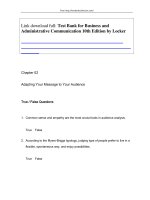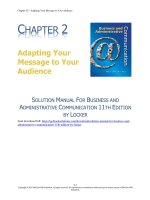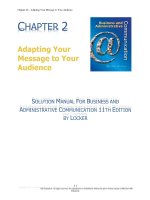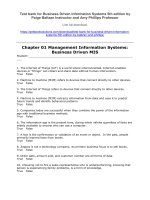Test bank for business and administrative communication 10th edition by locker
Bạn đang xem bản rút gọn của tài liệu. Xem và tải ngay bản đầy đủ của tài liệu tại đây (614.57 KB, 95 trang )
From />
Link download full: Test Bank for Business and
Administrative Communication 10th Edition by Locker
Chapter 02
Adapting Your Message to Your Audience
True / False Questions
1. Common sense and empathy are the most crucial tools in audience analysis.
True
False
2. According to the Myers-Briggs typology, judging type of people prefer to live in a
flexible, spontaneous way, and enjoy possibilities.
True
False
From />
3. The Myers-Briggs typology states that sensing type of people are good at facts,
and expect others to be as well.
True
False
4. The best way to handle the thinking type of audience is to use emotion and
personal scenarios to show how one's ideas value the needs of the people in the
organization.
True
False
5. The generational difference witnessed in office environments shows that
generation X and millenialsare largely motivated by duty to a company as
opposed to the older generation who are motivated by why a task is important.
True
False
6. Andrea Griffins works in a flat organization and thus can directly communicate
with the director or chief executive officer.
True
False
7. One can ask questions about the importance of friendship and social relationships
to analyze a company's discourse community.
True
False
From />
8. Questions about what media, formats, and styles being preferred for
communication are a good way of understanding a company's discourse
community.
True
False
9. Communication channels are identical in speed, accuracy of transmission, and
the ability to create goodwill.
True
False
10. It is more effective to use a written channel instead of an oral channel if one
wants an immediate response from an audience.
True
False
11. The political environment of an organization can impact an audience's reaction to
a message.
True
False
12. It is important to keep a message as short and crisp as possible when an
audience considers a message unimportant.
True
False
From />
13. A good way to handle a negative audience is by using condescending or hostile
phrases which will make them realize their mistake.
True
False
14. Placing old information in a subordinate clause helps an audience think of
background information needed to appreciate points in a message.
True
False
15. Making a message clear and unambiguous helps in handling an audience which
may oppose a message.
True
False
16. In a request which is time consuming or difficult, it is important to make the
actions seem complex which will challenge an audience to take on the task.
True
False
17. The best way to present audience benefits is by presenting good news in the
middle of a message.
True
False
From />
18. It is important to avoid using a salutation and close that remind an audience of
their membership in a group if everyone in an audience shares the same
experiences, goals, and values.
True
False
19. It is important to use the reader's first name in a salutation even if one is not
comfortable with first-name basis.
True
False
20. Audience benefits refer to advantages that the audience gets by using services,
buying products, following policies, or adopting ideas.
True
False
21. Good writers maintain one consistent style and approach for all audiences.
True
False
22. "You will be entitled to an all expense paid trip to London if you achieve the
quarterly target of 150 accounts" is an example of an intrinsic motivator.
True
False
From />
23. Intrinsic motivators are better than extrinsic motivators because research shows
that extrinsic motivators may actually make people less satisfied with the products
they buy or the procedures they follow.
True
False
24. Frederick Herzberg's study of professional employees found that the things
people liked about their jobs were all intrinsic motivators such as pride in
achievement, and enjoyment of work and responsibility.
True
False
25. Convincing the audience of a message's benefits involves two main steps of
making sure that the benefit really will occur, and explaining it to the audience.
True
False
26. If audience benefits do not use you-attitude in a message, a message is likely to
be ineffective.
True
False
27. One should identify the needs, wants, and feelings that may motivate an audience
if audience benefits are difficult to develop.
True
False
From />
28. While developing audience benefits, it is important to link the feature of a product
to the audience's needs and provide details to make the benefit vivid.
True
False
29. While writing for multiple audiences, it is vital to organize the message based on
the decision makers' attitudes toward it.
True
False
30. One should avoid providing an overview while writing for multiple audiences
because it takes the attention away from the body of the message.
True
False
Multiple Choice Questions
From />
31. Janice, a marketing executive at a clothing retail firm, is writing a proposal to
promote a new line of clothing for the company. While writing the presentation,
she keeps in mind, the marketing directors of the company who have the power to
adopt the plan. She also notes that her marketing manager will approve or reject
the proposal before it is presented to the directors of the company. On the day of
presenting the proposal, she notices that the promotional manager, advertising
manager, and the communications manager are also present to offer comments
on the proposal. Which of the following is most likely to be a gatekeeper for
Janice's proposal?
A. Promotional Supervisor
B. Communications Manager
C. Marketing Manager
D. Marketing Director
E. Advertising Manager
32. A _____ has the power to decide whether to accept a recommendation or not and
every message must reach this audience to fulfill its purpose.
A. gatekeeper
B. watchdog audience
C. primary audience
D. secondary audience
E. auxiliary audience
From />
33. Which of the following is an example of a primary audience?
A. An attorney who uses company documents as evidence of the organization's
culture and practices
B. A supervisor who controls the power to decide whether or not to send a
message to other audiences
C. A company president who reads minutes of departmental meetings to stay
informed, even though he plays no direct role
D. A client group who will decide whether or not to purchase a product based on a
sales proposal
E. A board of directors who do not have the power to stop a message but will use
its evaluation to monitor future actions
From />
34. John Moreno is a technical writer who is working on a training manual to help new
users learn the company's data management system. Employees will use the
manual in training seminars taught by the company's trainers. The manual will
also serve as an on-the-job reference. The trainers and system analysts who
designed the computer system will need to offer their comments on Moreno's
draft. What kind of an audience will the trainers be classified as?
A. Watchdog
B. Gatekeeper
C. Primary
D. Secondary
E. Auxiliary
From />
35. Carlos Diaz works in the collections section of a bank's loan department, and is
very efficient at writing professional, effective letters to customers whose
accounts are overdue. The human resources department asks to use copies of
some of his letters in a training course for new employees to show good
examples of written documents. Under which of the following categories would
these new employees be classified?
A. Primary audience
B. Gatekeepers
C. Watchdog audience
D. Secondary audience
E. Auxiliary audience
From />
36. Jean Welch has recently started working as a copywriter at an advertising agency
and has been asked by her manager to write a proposal for a client's social media
campaign. This is the first time that Welch is going to present a proposal and
understands that though the company's board of directors will not directly act on
it, they will be paying careful attention to the interaction between her and the
client. Which of the following audiences can the board of directors be categorized
under?
A. Primary audience
B. Watchdog audience
C. Secondary audience
D. Auxiliary audience
E. Gatekeeper
37. The ability to put yourself in someone else's shoes and to feel with that person is
known as _____.
A. common sense
B. professionalism
C. intuition
D. empathy
E. sympathy
From />
38. The _____ dichotomy of the Myers-Briggs Type Indicator measures how
individuals prefer to focus their attention and derive energy.
A. extroversion-introversion
B. sensing-intuition
C. thinking-feeling
D. judging-perceiving
E. channeling-formatting
39. Raymond Dean works in the human resource department of a five star deluxe
hotel in Las Vegas and needs to recruit people for the post of floor managers in
the guest relations department. These recruits will have to be sensitive to inhouse guests' requirements and make crucial decisions keeping in mind their
preferences. Which of the following dichotomies of Myers-Briggs Type Indicator
will best help Dean in recruiting?
A. Sensing-intuition
B. Channeling-formatting
C. Thinking-feeling
D. Judging-perceiving
E. Extroversion-introversion
From />
40. Rebecca Harvey, who works as a marketing executive at a travel company, was
recently asked by her manager to provide an update on the campaign she is
working on. Instead of giving the manager details through a face-to-face
interaction, she chose to write an e-mail. She knew she will have more time to
formulate the campaign update if she chooses a written mode of communication.
According to Myers-Briggs Type Indicator, which of the following personality types
is Harvey?
A. Extroverting
B. Intuiting
C. Thinking
D. Introverting
E. Judging
41. According to the Myers-Briggs Type Indicator, the _____ dichotomy measures the
way an individual prefers to take in information.
A. channeling-formatting
B. thinking-feeling
C. sensing-intuition
D. judging-perceiving
E. extroversion-introversion
From />
42. Amanda George needs to give a presentation on "Drug and Alcohol Abuse" to
college students in Michigan. Before preparing the presentation, she analyzes the
audience and realizes that the presentation needs to focus on the underlying
patterns of the issue. In the presentation, she uses metaphors and case studies
as examples of severe drug abuse cases. Which of the following types according
to the Myers-Briggs Type Indicator is George's audience?
A. Sensing
B. Perceiving
C. Intuiting
D. Extroverting
E. Judging
43. Mildred Gilbert, who works for a travel company, recently gave a presentation to
her manager on a marketing plan for the next financial year. In the presentation,
she ensured that all communication was well organized, and all procedures
followed a distinct structure and timeframe. Which of the following personality
types was Gilbert's audience according to the Myers-Briggs Type Indicator?
A. Perceiving
B. Sensing
C. Intuiting
D. Extroverting
E. Judging
From />
44. Naomi works at an event management company and is popular among her clients
for her ability to adapt to changing situations and client requirements with ease.
She also avoids making impulsive decisions and gathers all necessary
information before implementing an action. According to the Myers-Briggs Type
Indicator, she qualifies as the _____ type.
A. perceiving
B. judging
C. thinking
D. intuiting
E. introverting
45. Which of the following is an example of demographic data?
A. Moral values
B. Educational level
C. Social security number
D. Personality types
E. Intellect
From />
46. Which of the following is an example of a psychographic characteristic?
A. Age
B. Goals
C. Location
D. Education
E. Race
47. Beverly Vaughn recently gave a presentation on "The Benefits of Investing in
Frank Middleton Mutual Funds." The seminar was a big success and Vaughn
gives its credit to careful analysis of the audience's psychographic characteristics.
Which of the following characteristics does the analysis most likely indicate?
A. Over 40 percent of the audience believes in ensuring security during old age.
B. Over 70 percent of the group members are scientists with Ph.D. degrees.
C. At least 20 percent of the audience members are nearing retirement age.
D. Nearly 35 percent of the participants are from Asian backgrounds.
E. Approximately 25 percent of the audience's participants are women.
From />
48. Tiffany Miles, who works as a human resource executive, recently recruited
members for the communication team of their organization. She has noticed that
all of the new employees were born after the year 1964 and distinctly differ from
the rest of the age group of the company. Which of the following would best help
Miles handle them and avoid dissatisfaction of employees?
A. Ensure they put in long hours at office and have an annual evaluation
B. Offer a formal, hierarchical work structure with basic decorum
C. Provide clearly defined roles for them to excel in
D. Motivate them by explaining them what they gain from a task
E. Inspire them to work by emphasizing on duty toward the company
49. Zoë works for a fashion house in Manhattan and recently gave an oral
presentation to her colleagues on a marketing plan for a line of woolen clothing.
The presentation was liked by everyone in the audience. Zoë feels the
presentation was a success because she chose the oral medium of
communication instead of a written medium. Which of the following did Zoë most
likely present in her presentation?
A. Extensive data about marketing plans
B. Complex statistical information about markets rates
C. Specific, minute details about the marketing plan
D. Lengthy data about successful marketing plans
E. Passion and emotion about the plan
From />
50. Esther Rhodes recently gave a presentation to a group of college students on
"Impacts of Climate Change." However, the members in the audience did not see
the message of the presentation as crucial. Which of the following will help Esther
change their view to a more positive one?
A. Making the message longer and as descriptive as possible
B. Suggesting an idealistic deadline for action to curb climate change
C. Making the action seem difficult which will challenge the audience
D. Using the first paragraph to show that the message is relevant
E. Projecting action to prevent climate change as strenuous
51. Loretta Jones, who works as a sales manager in a telecom company, needs to
present a report to the directors at the end of every financial year on the sales
generated by the company. For her upcoming presentation, which of the following
statements should she use for the audience to recall the background on
company's growth presented in her last report?
A. "As you know, the company had a 25 percent increase in sales last year."
B. "Does anyone remember the sales figures of last year?"
C. "You may not recall but the company's sales rose by 25 percent last year."
D. "The company's sales rose by a significant 25 percent last year."
E. "All of you, who remember last year's sales figures, please raise your hands."
From />
52. Claudia Walsh, an insurance agent, recently gave a presentation to a client on
long-term investment policies. Initially, the client was skeptical about the
investment products but by the end of the presentation, they gave a positive
response. Which of the following did he most likely do?
A. Walsh was as ambiguous as possible to avoid offending the members of the
audience.
B. Walsh began the message with something that the audience and the presenter
could agree upon.
C. Walsh put across the message aggressively to prove it as the best solution,
even though it angered the audience.
D. Walsh delivered all aspects and details about the message at once instead of
limiting the message.
E. Walsh was vague about the concerns the audience had in order to avoid
confrontation.
From />
53. Leona Benson e-mails her colleague, Miriam Wolfe, to suggest that she should
write a comprehensive business plan for the company. The task will be rather
challenging and time-consuming; however, Miriam still takes up the task. Which of
the following did Benson most likely say to Wolfe that motivated her to take up the
task?
A. "The company will be able to secure additional financing once it has a business
plan."
B. "The President will be able to use the document to communicate expansion
plans to stockholders."
C. "You will gain key writing experience that will help you in your future projects."
D. "I will be very grateful if you can help me out by taking on this task."
E. "You will be able to strengthen our team's image by taking up the task."
54. Which of the following is most likely to be an audience benefit?
A. Features of a product
B. Level of formality in a document
C. Loopholes of a product
D. Tips on how to use a product
E. Steps on how to maintain a product
From />
55. Naomi Moss, a sales executive at an insurance firm, is working on convincing a
large corporate client to insure their employees. Though she knows that the task
is a difficult one, she is keeping her focus on the objective to be achieved. Her
motivation comes from an extrinsic factor and knows that she will succeed if she
continues working at the current rate. Which of the following is most likely an
extrinsic motivator that is inspiring Moss to make a sale?
A. A high sales commission for the sale
B. Delight in solving a complicated work problem
C. Pleasure in making a large sale for the company
D. Pride in having strong public relation skills
E. Excitement of contributing to her team's target
56. Peter Cat, a fast food chain in Mexico, recently conducted a survey to understand
what motivated their employees in their work. To their surprise, they noticed that
over 85% of employees were inspired to perform better by intrinsic factors as
opposed to extrinsic factors. Which of the following is most likely to be an intrinsic
motivator for their employees?
A. Earning a high sales commission
B. Being rewarded with a trip to the Bahamas
C. Being valued by the company
D. Receiving good performance evaluations
E. Enjoying perks and added benefits
From />
57. Barbeque, a new restaurant in Mexico City, advertised themselves through
newspaper ads which generated a large customer base. Which of the following
did the restaurant most likely say in their ad which represented you-attitude?
A. At Barbeque, we offer the best grills in the city!
B. We offer the quickest serving grills here!
C. The best serving grills in Mexico City!
D. If you love grills, try our barbeque dishes!
E. We love barbeque, and it shows in our food!
58. Paul Jones, an eatery at New York's Central Park, attracts more customers than
any other in that commercial hub. The marketing manager of the company says
that the reason for such a wide customer base is because they appeal to the
large working sub group in the area who are pressed for time. Which of the
following objective features does Paul Jones most likely focus on that meets the
needs of working sub group?
A. High rise chairs
B. Low sodium and carb-food
C. Economic prices
D. Quick lunches
E. Tasteful décor
From />
59. Sally and Ryan are working professionals and have hectic work schedules with no
time for entertainment during weekdays. However, on Saturdays, they try out new
restaurants and make sure that they unwind and ease out their week's stress over
dinner. Which of the following would help a restaurant appeal to Sally and Ryan's
requirements?
A. Vegetarian food
B. Popular live band
C. Quick serving dinners
D. No tipping policy
E. Economic food
60. Which of the following should be undertaken to addresses multiple audiences with
different needs?
A. Using personal pronouns to ensure that all members of the audience have the
same interpretation
B. Writing a document in an informal style, if it is meant for both internal and
external audiences
C. Placing background and explanatory information under the same heading
D. Using table of contents so that readers can turn to the portions that interest
them
E. Avoiding assumption on the degree of knowledge that decision makers will
have
From />
Short Answer Questions
61. Explain how a primary audience differs from a secondary audience?
62. Discuss how a watchdog audience is different from a gatekeeper and an auxiliary
audience.
